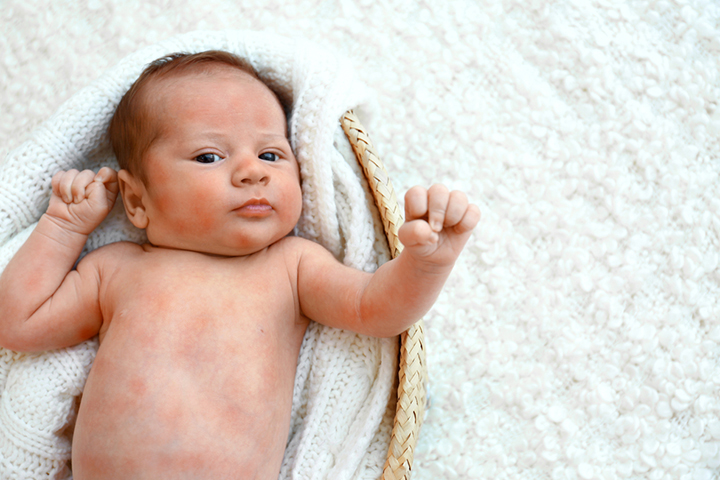
Image: Shutterstock
Selecting the perfect clothing for our precious babies is an incredibly important task, as their delicate and sensitive skin requires extra care and attention. In today’s market, we are inundated with a plethora of clothing options, making it important for us to carefully consider the material composition when dressing our little ones. Synthetic clothing has seen a surge in popularity in recent years due to its affordability and durability. However, it is vital for us to truly comprehend why synthetic clothing falls short when it comes to meeting the needs of your beloved babies.
1. Skin Sensitivity And Irritation
Image: Shutterstock
Babies possess skin that is remarkably delicate and sensitive, rendering them more susceptible to irritation and allergic reactions. Synthetic fabrics, including polyester, nylon, and acrylic, are derived from petrochemicals and frequently contain harsh dyes and chemicals. Unfortunately, these materials hinder adequate breathability, thereby trapping heat and moisture against the baby’s skin. As a consequence, discomfort, rashes, and skin irritations may arise. Thus, it becomes crucial to prioritize natural fibers such as cotton, bamboo, or organic fabrics, which offer a gentle and skin-friendly alternative for your little ones.
2. Breathability And Thermal Regulation
Synthetic fabrics have garnered a reputation for their lack of breathability, impeding the free circulation of air. Consequently, this can result in overheating and excessive sweating, thereby heightening the likelihood of heat rashes and overall discomfort for your precious babies. In contrast, natural fibers excel in terms of breathability, enabling proper ventilation and facilitating the maintenance of a comfortable body temperature. Fabrics such as cotton and bamboo possess remarkable moisture-wicking properties, actively absorbing and evaporating sweat, thus ensuring that the baby’s skin remains dry and cool throughout their daily adventures.
3. Chemical Exposure
Image: Shutterstock
During the manufacturing process, synthetic clothing frequently undergoes chemical treatments that involve the application of dyes, flame retardants, and finishing touches containing formaldehyde. Unfortunately, these chemicals can prove to be detrimental to a baby’s delicate skin, resulting in allergic reactions and skin irritation. Opting for natural and organic fabrics serves as a proactive measure in mitigating the exposure of babies to these harmful substances, effectively safeguarding their safety, well-being, and long-term health.
4. Comfort And Freedom Of Movement
Babies need comfortable clothing that allows them to move freely as they explore the world around them. Synthetic fabrics often lack the softness and flexibility offered by natural fibers, restricting movement and causing discomfort. Natural fabrics like cotton and bamboo provide a gentle and stretchable feel, allowing babies to move, crawl, and play without any hindrance. The softness of these fabrics also ensures that there are no harsh friction points that could cause skin irritation or discomfort for the little ones.
Choosing the right clothing for babies involves considering the alternatives to synthetic fabrics. Fortunately, there are several natural and organic options available that offer comfort, breathability, and safety for your little ones.
1. Cotton: The Classic Choice
Image: Shutterstock
Cotton, a timeless and widely favored fabric, stands as a perfect choice for dressing our little ones. Its softness, breathability, and hypoallergenic nature make it incredibly gentle on a baby’s delicate skin. Cotton fabrics facilitate the circulation of air, effectively preventing overheating and fostering a heightened sense of comfort. Furthermore, cotton is remarkably easy to care for, enduring in its durability, and conveniently available in a myriad of styles and designs, offering a wide range of options to suit individual preferences.
2. Bamboo: Eco-friendly And Luxuriously Soft
Bamboo fabric has been increasingly embraced as a remarkable substitute for synthetic clothing when it comes to dressing your little ones. Derived from the bamboo plant, renowned for its sustainability and rapid growth, bamboo fabric exhibits exceptional qualities. It’s incredibly soft texture, hypoallergenic nature, and remarkable breathability make it an ideal choice, particularly for sensitive skin.
Much like cotton, organic bamboo fabric is crafted without the use of harmful chemicals, rendering it a safe and environmentally friendly option for your precious baby. Moreover, bamboo possesses inherent moisture-wicking properties, ensuring that your little one remains dry and comfortable throughout the day.
3. Linen: Lightweight And Cooling
Image: Shutterstock
Linen is a natural fabric made from the flax plant, known for its lightweight and cooling properties. It is highly breathable, allowing air to circulate freely and preventing excessive sweating. Linen fabric is also absorbent, wicking away moisture from the skin and keeping babies dry.
When it comes to dressing your precious little ones, their delicate skin deserves the gentle touch of natural fibers. Cotton, bamboo, and organic fabrics offer comfort, breathability, and safety. Cotton embraces them with a warm caress, allowing air to circulate freely. Bamboo fabric, like a cloud, soothes their skin with softness and keeps them dry. Organic fabrics, free from harmful chemicals, demonstrate our commitment to their well-being and the environment. Let’s make informed choices that speak volumes, creating a greener world for our children. Together, we say “no” to synthetic clothing and embrace a future where love, comfort, and sustainability prevail.
















